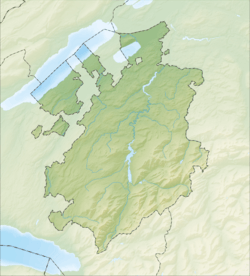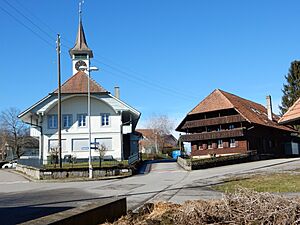Lurtigen facts for kids
Quick facts for kids
Lurtigen/Lourtens
|
||
|---|---|---|
|
||
| Country | Switzerland | |
| Canton | Fribourg | |
| District | See | |
| Area | ||
| • Total | 2.30 km2 (0.89 sq mi) | |
| Elevation | 567 m (1,860 ft) | |
| Population
(Dec 2014)
|
||
| • Total | 183 | |
| • Density | 79.6/km2 (206.1/sq mi) | |
| Postal code |
3215
|
|
| Surrounded by | Büchslen, Staatswald Galm, Gempenach, Murten/Morat, Salvenach, Ulmiz | |
Lurtigen (German) or Lourtens (French) was a small town, also called a municipality, in Switzerland. It was located in the canton of Fribourg. Even though Fribourg is mostly French-speaking, Lurtigen had many German speakers.
On January 1, 2016, Lurtigen joined with three other towns: Courlevon, Jeuss, and Salvenach. They all became part of the larger town of Murten.
Contents
What is the History of Lurtigen?
Lurtigen is an old settlement. It was first written about in the year 1397. Back then, it was called Lurtens. Later, in 1508, people referred to it as Lurting.
Where is Lurtigen Located?
Lurtigen was a small area, covering about 2.32 square kilometers (0.89 square miles). A big part of this land, about 59.5%, was used for farming. Forests covered another large section, about 33.6% of the area. The remaining 6.0% was where buildings and roads were located.
The town was nestled in the See/Lac district. It sat in a small open area between the towns of Morat and Laupen. This clearing was completely surrounded by woods. This kind of location is quite special in the Swiss Plateau, which is a flat area in Switzerland.
What Does Lurtigen's Coat of Arms Look Like?
Every town has a special symbol called a coat of arms. Lurtigen's coat of arms has a silver background. On it, there are three red roses placed one above the other. These roses look natural, with their seeds and thorns shown.
Who Lived in Lurtigen?
In 2014, Lurtigen had a population of 183 people. All of them were Swiss citizens. Over ten years, from 2000 to 2010, the number of people living there went down a little.
Most people in Lurtigen spoke German as their main language. In 2000, about 97.8% of the people spoke German. A small number, about 1.1%, spoke French. Even fewer, about 0.6%, spoke Portuguese.
In 2008, the population was almost evenly split between males and females. About 50.6% were male and 49.4% were female. Most of the people living in Lurtigen in 2000 were born there. Others were born in the same canton or elsewhere in Switzerland.
Young people, aged 0 to 19, made up about 26.8% of the population in 2000. Adults, aged 20 to 64, were the largest group at 62.6%. Older people, over 64, made up about 10.6% of the population.
There were 69 homes in Lurtigen in 2000. On average, about 2.6 people lived in each home. Most of the apartments were lived in all year round.
Here is a chart showing how Lurtigen's population has changed over many years:

What Can You See in Lurtigen?
The entire village of Lurtigen is considered a special place. It is part of the Inventory of Swiss Heritage Sites. This means it has historical or cultural importance and is protected.
How Did People Make a Living in Lurtigen?
In 2010, the unemployment rate in Lurtigen was very low, at 0.7%. This means almost everyone who wanted a job had one.
In 2008, people worked in different types of jobs:
- Primary sector: This includes jobs like farming. About 37 people worked in this area.
- Secondary sector: This includes jobs in factories or construction. About 17 people worked here.
- Tertiary sector: This includes jobs that provide services, like education or sales. About 5 people worked in this sector.
Many people who lived in Lurtigen traveled to other towns for work. In 2000, 77 people left Lurtigen to work elsewhere. Most people, about 62.7%, used a private car to get to their jobs. A smaller number, 4.5%, used public transportation.
What Religions Were Practiced in Lurtigen?
Based on information from 2000, most people in Lurtigen were Christian. About 79.9% belonged to the Swiss Reformed Church. Another 6.1% were Roman Catholic. Some people belonged to other Christian churches. A small number of people did not belong to any church.
How Was Education in Lurtigen?
Education is very important in Switzerland. In Lurtigen, about 45.8% of the people had finished upper secondary education. This is like high school. About 12.3% had gone on to higher education, like university.
The school system in Fribourg canton starts with one year of optional Kindergarten. Then, students go to six years of Primary school. After that, there are three years of lower Secondary school. Students are grouped based on their abilities.
After lower Secondary, students can choose to go to an upper Secondary school for three or four years. This can be a gymnase (which prepares them for university) or a vocational program (which teaches job skills). After this, they can go to a university or start an apprenticeship.
In the 2010-2011 school year, Lurtigen had one primary class with 24 students. Some students from Lurtigen went to schools in nearby towns for kindergarten, lower secondary, or higher education.
See also
 In Spanish: Lurtigen para niños
In Spanish: Lurtigen para niños





